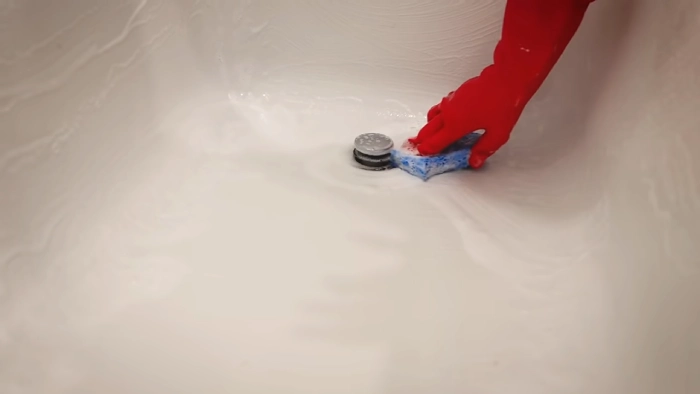Last Updated on October 16, 2023
Cleaning a plastic tub surround is never easy because one wrong move and your shiny new bathtub could look worse with scratches. The question arises of how you can safely scrub away dirt and soap scum without damaging the material.
Vinegar, dish soap, bleach solution, DIY degreaser, baking soda, and all-purpose cleaners are some of the best ways to clean a plastic tub surround. You should use soft cloths such as microfiber or terry towels, sponges, or rags when cleaning a plastic tub enclosure.
Steer clear of steel wool, scouring pads, and melamine sponges can scratch the surface. Definitely don’t use commercial abrasive cleaning products or solvents either. Let us share all the details on how to keep your plastic tub looking as good as new.
How To Clean Plastic Tub Surround: 6 Effective Methods
Cleaning a plastic tub surround does not have to be hard or time-consuming if done properly. The key is to use mild cleaning solutions like vinegar, baking soda dish soap, bleach, mixer degreaser, and all-purpose cleaners for the best results.
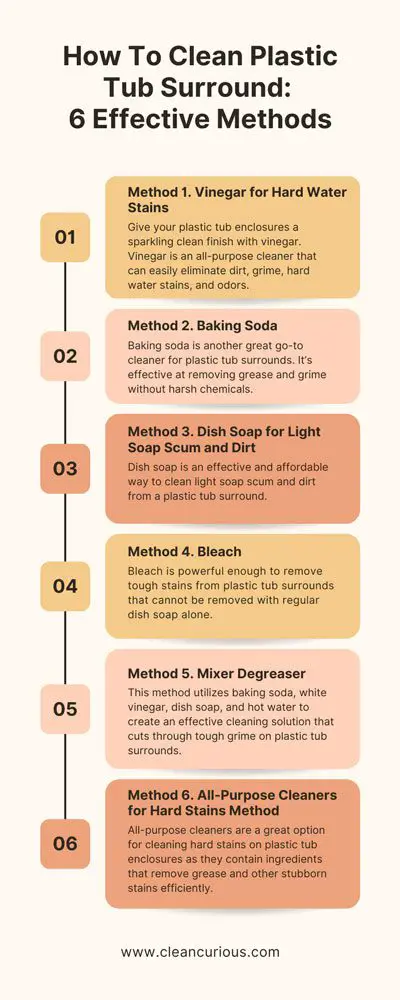
Method 1. Vinegar for Hard Water Stains
Give your plastic tub enclosures a sparkling clean finish with vinegar. Vinegar is an all-purpose cleaner that can easily eliminate dirt, grime, hard water stains, and odors.
![How To Clean Plastic Tub Surround: 6 DIY Methods [Effective]](https://cleancurious.com/wp-content/uploads/2023/02/How-To-Clean-Plastic-Tub-Surround-1.jpg)
Step 1. Simply pour some white vinegar into a spray bottle and spritz it over the greasy tub surface.
Step 2. Allow the vinegar to sit for 15 minutes before scrubbing it away with a microfiber cloth or soft sponge.
Step 3. Rinse off any remaining residue with fresh water.
For an even more refreshing smell, you can swap out the vinegar for some lovely lemon juice.
Method 2. Baking Soda
Baking soda is another great go-to cleaner for plastic tub surrounds. It’s effective at removing grease and grime without harsh chemicals.
Step 1. Make a thick paste of baking soda similar to peanut butter or toothpaste consistency. With your fingers or a clean, soft cloth, apply the baking soda paste over the greasy surfaces.
Step 2. Let the baking soda paste sit for five minutes before using a soft sponge or scrubbing brush to lightly rub away any residual dirt or grime.
Step 3. Rinse off the baking soda paste with some fresh water and enjoy your newly refreshed plastic tub surround.
Method 3. Dish Soap for Light Soap Scum and Dirt
Dish soap is an effective and affordable way to clean light soap scum and dirt from a plastic tub surround. Steps for cleaning plastic tub surrounded with dish soap:
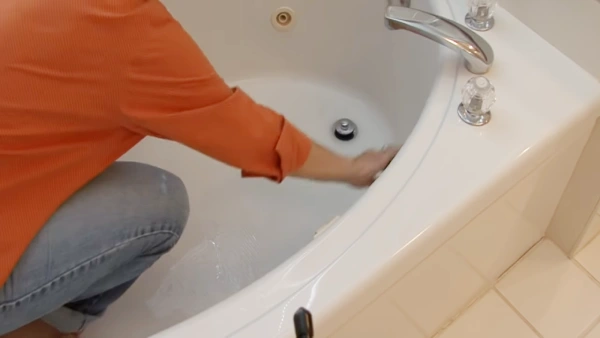
Step 1. Begin by mixing two tablespoons of dish detergent into one gallon of warm water in a spray bottle, stirring thoroughly until fully combined.
Step 2. Spray the soapy mixture onto the plastic tub surround and let it sit for at least five minutes before scrubbing.
Step 3. Using either a terry cloth towel or microfiber cloth, scrub the surface of the tub surround until all dirt and grime have been removed.
Step 4. Once done scrubbing, use clean water to wash away any residual soap residue. Wait until the plastic tub surround is completely dry before you start using it again.
Method 4. Bleach
Bleach is powerful enough to remove tough stains from plastic tub surrounds that cannot be removed with regular dish soap alone. But it should be used carefully as it can damage some surfaces if not handled properly.
Step 1. Put on protective gloves before handling any bleach solution, as this will protect your skin from any splashes or spills that may occur during the cleaning process.
Step 2. Create a bleach solution by mixing two tablespoons of bleach into two cups of water in a bowl or bucket.
Step 3. Submerge a cleaning tool, such as a soft-bristled brush, into the bleach solution. Let it sit for 30 minutes up to an hour before using it against the surface of your plastic tub surround.
Step 4. Using circular motions around the entire surface area, slowly scrub away at tough stains until they are no longer visible on the surface.
Step 5. Rinse away all traces of bleach residue using clean water after each application until all stains are gone.
Step 6. Allow the plastic tub surround to dry completely before being used again afterward.
Method 5. Mixer Degreaser
This method utilizes baking soda, white vinegar, dish soap, and hot water to create an effective cleaning solution that cuts through tough grime on plastic tub surrounds.
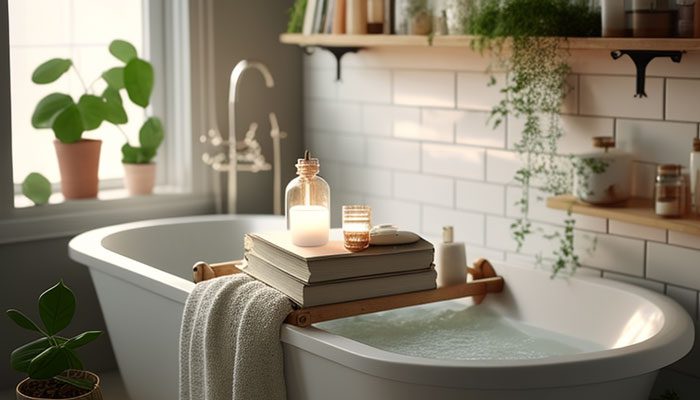
Step 1. To begin this process, you will need to prepare the mixture by combining one part vinegar and one part baking soda together in a bowl.
Step 2. Then add 1 tablespoon of dish soap followed by three parts hot water. The resulting solution should then be stirred with a spoon until it is completely blended together.
Step 3. Once ready, soak a microfiber cloth within this solution before scrubbing the plastic tub surrounding it gently.
Step 4. Once you’ve scrubbed the desired area thoroughly, rinse away any remaining residue with cold water.
Method 6. All-Purpose Cleaners for Hard Stains Method
All-purpose cleaners are a great option for cleaning hard stains on plastic tub enclosures as they contain ingredients that remove grease and other stubborn stains efficiently. These cleaners are gentle on surfaces so as not to damage them in the process.
Step 1. Start by spraying your cleaner directly onto the affected area of the plastic tub surround. Allow it to sit for several minutes to allow it to absorb any dirt or grime present on its surface.
Step 2. After letting it sit for several minutes, use a soft cloth or sponge dipped in warm water and gently scrub away at the stain until it has been removed.
Step 3. Once done, wash away any remaining substance with clean water.
What Cleaning Products Can You Use?

1. Vinegar:
When cleaning a plastic bathtub surround, vinegar( lemon juice) is an effective option that may be used. Its acidic substances can help to remove stubborn dirt, soap scum, and other debris from the surface.
2. Mild Dish Soap:
Mild dish soap can also be used to clean the plastic tub surround as it is gentle yet effective for removing dirt and grime.
3. Diluted Bleach:
Diluted bleach is another great option for cleaning bathtub surrounds. It can help to sanitize the surface but should never be used in its concentrated form because it can damage the plastic surface.
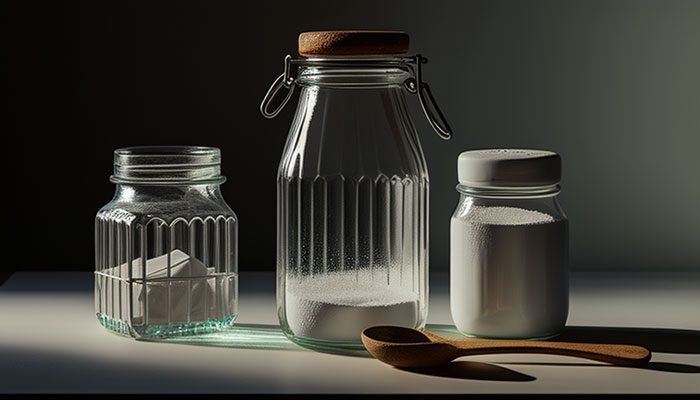
4. Baking Soda:
Baking soda paste is also an excellent choice for cleaning a plastic tub surround. It works to gently exfoliate away dirt and grime while being safe for use on most surfaces.
5. All-purpose Cleaners:
Commercial all-purpose cleaners are typically safe to use on plastic tub surrounds as they are formulated specifically for this purpose. Ensure to take a look at the label for important details like “non-abrasive” and whether it’s suitable for materials such as plastic, ABS, polystyrene or acrylic.
What Cleaning Products Should You Avoid?
When cleaning a plastic or ABS tub enclosure there are certain products that should be avoided.
Scouring Powders: Abrasive cleaners such as scouring powders should not be used on any kind of plastic surface as they can cause scratches or damage to the material.
Solvents: It’s really important to remember not to use solvents like mineral spirits, acetone and turpentine on any type of plastic surface. They have the potential to leave behind residues that could harm the material.
Harsh chemical cleaners: Harsh chemical cleaners like oven cleaner or drain cleaner are also not suitable for plastic material. Their caustic nature could damage the surface or, even worse, cause etching if contact with the skin occurs.
What Cleaning Materials You Should Use?

Microfiber Cloths:
For effective cleaning of a plastic tub surround, microfiber cloths should be used. They are highly absorbent and can easily collect dirt, dust, and grime without leaving behind streaking or residue.
Microfiber cloths come in a variety of sizes and can be washed and reused multiple times. They are gentle on the surface of the plastic tub, so no damage will be caused by using them.
Terry Cloth Towel:
If the dirt is particularly stubborn and difficult to remove, it may be wise to use something more abrasive like a terry cloth towel. They have more texture which allows them to break up dirt easier.
Terry cloth towels also have some absorbency but need to be replaced more frequently than microfiber cloths do, as they deteriorate quickly with washing.
Soft Sponges:
Soft sponges are also useful for cleaning plastic tub surrounds as their shape makes them ideal for reaching into corners and other areas that might otherwise go uncleaned. They also won’t harm the surface of the tub, so it can remain scratch-free during cleaning.
Soft Rags or Scrubbers:
Soft rags or scrubbers may also be used as needed but should only do so if absolutely necessary- these tools can leave scratches if not handled properly so caution should be taken when using them for tough stains or debris.
What Cleaning Materials Should You Not Use?

Steel Wool: A steel wool pad in particular is especially damaging as its coarseness makes it too abrasive even when trying to remove tough grime. Therefore it should always be avoided when cleaning any type of plastic tub surround surface.
Scouring Pads: Scouring pads, too, could cause scratching due to their rough texture so these should not be used either.
Melamine Sponges: As for melamine sponges, while their softness prevents them from causing deep scratches like steel wool does. Their uneven texture can still lead to light scratching which ruins the appearance of a smooth finish on a bathtub surrounding area.
Can Yellowed Plastic Be Whitened?
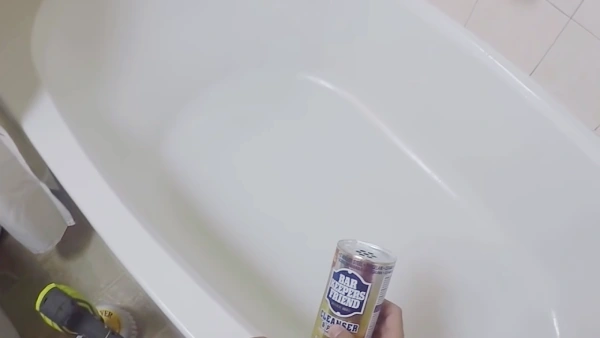
Yellowed plastic can be whitened by using cream peroxide or tartar. Before attempting this process, the plastic should be thoroughly cleaned and dried.
Once clean, a thin coat of either cream peroxide or tartar should be applied evenly to the entire surface of the plastic. This will help to effectively remove the yellowing from the plastic and leave it with a white finish.
Will Vinegar Damage Plastic Tub Surrounds?
Vinegar will not damage a plastic tub surround when used for cleaning purposes. In fact, white vinegar is often used as an all-natural cleaner for removing mildew from surfaces like bathtubs and shower surrounds made of plastic materials.
Can You Resurface a Plastic Tub Surround?
You can resurface plastic by using specialized products designed specifically for this purpose. These usually come in the form of spray-on coatings.
They can be directly applied to the surfaces of tubs and shower enclosures composed primarily of plastics such as acrylics and polymers. The coating provides protection against discoloration from ultraviolet rays.
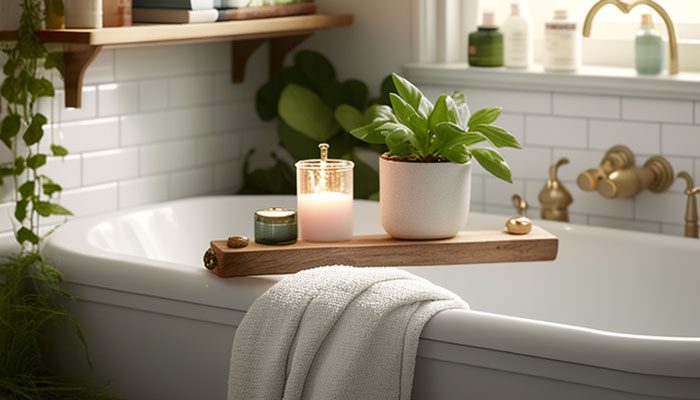
Restore the Shine of Your Plastic Tub Surround Easily
Don’t worry if your plastic tub surround looks old because the right cleaning solutions will make it look brand new. Vinegar, lemon juice, all-purpose cleaner, and baking soda paste can be used for ultimate cleanliness.
Be sure to choose soft clothes such as microfiber cloth or terry towels for best results. Avoid steel wool, scouring pads, melamine sponges, and commercial abrasive cleaning products, along with solvents. Proper maintenance ensures that your plastic tub will stay in perfect condition.

